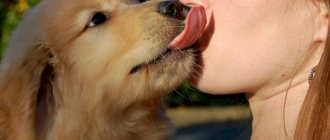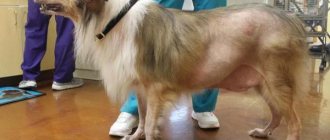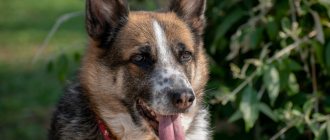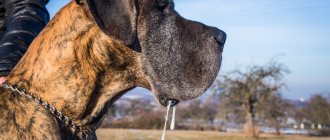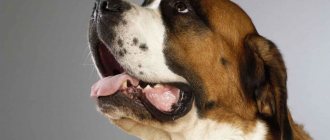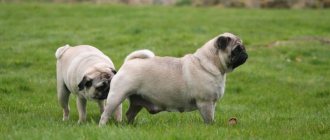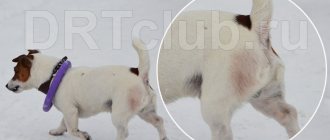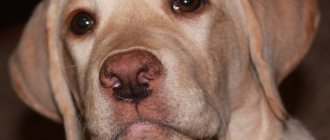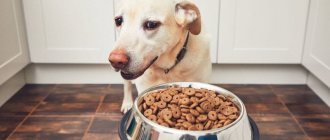April 13, 2018
Just yesterday the pet ran as fast as he could to the bowl, but today the dry food remained untouched. You worry and try to feed your picky dog at any cost, but he becomes more and more capricious...
What to do if your dog stops eating dry food? First of all, calm down and realize: you are the master of the situation and must solve the problem.
Loss of appetite or moodiness?
Very often, dog owners, having noticed their pet’s reluctance to eat dry food, quickly begin to feed the pet with other food, in the worst case, from the table, which only aggravates the problem. After all, given the opportunity to choose, the dog will probably prefer natural food to dry food, since it has a more attractive and intense smell. At the same time, animals very quickly get used to the fact that they can always beg for a treat and begin to ignore the main diet.
So, if a dog stubbornly refuses dry food, but at the same time happily eats other food, then most likely it’s a matter of whims. The only fail-safe method of dealing with them is a starvation diet. After your pet has turned away from the bowl filled with food, remove the food until the next feeding. Repeat the procedure again if necessary.
A short diet will not harm your dog
There is no need to worry that your pet is starving: a dog can easily go without food for several days or even more without harm to its health. The most important thing during such a “diet” is no indulgences, treats or delicacies. The dog must firmly understand that the only alternative to dry food is hunger.
As a rule, one or two missed feedings are enough to completely normalize the situation. In the future, if the animal does not eat the food completely, measure the remainder and adjust the portion next time. It is possible that your pet simply needs less food than you offer it.
Some dogs refuse food for about a day for no apparent reason, arranging fasting days for themselves, and this is the norm. In addition, there are external factors, such as stress or extreme heat, that affect appetite. As a rule, it recovers on its own after the dog feels better, and there is no need to worry too much about it. Just make sure your pet always has access to clean water.
What to do if your dog has no appetite
If the reluctance to eat is not associated with infectious, viral, helminthic diseases, or serious poisoning, you can help the animal yourself. In any other cases, self-diagnosis and treatment is dangerous; the animal must be entrusted to a veterinarian.
You can improve your appetite in the following ways:
- Skip feeding. For 24 hours, do not offer the dog absolutely any food (especially treats from the table). Clean and fresh water must be freely available. In most cases, one skipped meal is enough to restore your previous appetite.
- Diversify your dog's diet. Introduce more healthy foods into the animal’s food (fermented milk, offal, fresh vegetables, fish), since an unbalanced diet can cause refusal to eat food.
- Reduce food portions. If the dog leaves food in the bowl, the portion of food may be too large and the animal is simply not able to eat it.
- Monotonous food. Feeding your pet only rice or buckwheat may cause reluctance to eat. By diversifying the diet with other cereals, meat and vegetables, it is quite possible to restore the animal’s appetite in the shortest possible time.
- Increase the duration of walking and the intensity of physical activity. Usually, after long and active walks, the dog greedily pounces on the food offered to it.
- If there are obvious signs of poisoning (when the animal is not in serious condition), the stomach is washed with baking soda or a solution (weak) of potassium permanganate and activated carbon is given at the rate of 1 tablet per 10 kg of pet’s weight. In severe cases of poisoning, the dog is immediately taken to the veterinarian.
The pet has health problems
Except for those cases that we have listed, a complete refusal to eat or a significant decrease in appetite, regardless of the type of food, almost always indicates problems with the dog's health, which, of course, are accompanied by other symptoms. It could be:
- temperature increase,
- diarrhea,
- vomit,
- lethargy,
- rapid breathing,
- discharge from the eyes or nose.
In this case, it is advisable to consult a veterinarian as soon as possible. For example, an ixodid tick bite is quite capable of leading to the development of babesiosis in a dog, which, in the absence of competent and timely treatment, often ends in death. Moreover, the first symptom of piroplasmosis (babesiosis) in dogs is precisely a sharp decrease in appetite until it completely disappears.
Inflammation of the gums and dental problems can also lead to refusal of dry food. True, the appetite, as a rule, does not decrease, and the dog, feeling hungry, still tries to eat, but drops the granules on the floor, moves away, approaches the bowl again, whines, etc. The owner should pay attention to this behavior and take the pet to a veterinarian.
Why doesn't my dog want to eat dry food?
First of all, make sure your pet is healthy. Pay attention to the general condition of the animal and its behavior. Go to the veterinarian if you notice any of the following signs:
- Lethargy, depression, diarrhea, vomiting or constipation may indicate diseases of the internal organs.
- Inspect your dog's body for ticks, skin irritations, or hair loss.
- Look into your mouth and check for ulcers and inflammation on your gums and tongue. Is the smell from the mouth normal?
- A stuffy nose leads to loss of smell and appetite.
If nothing suspicious is found, then the refusal is not related to health complications. Sometimes even small changes in a dog's diet or life can cause a decrease in appetite and aversion to food.
Other possible reasons:
- If your dog refuses the food he was eating before, the quality may have decreased. It is difficult for a person to distinguish a fake from the real composition, but a dog’s nose will quickly smell the substitution.
- Changing the manufacturer may also not be beneficial. The dog is accustomed to one diet and may not like another.
- Pay attention to the expiration date of the product. Perhaps the pellets have deteriorated and the animal smells rancid.
- If there is stale water next to the food or no water at all, the dog will refuse to eat. Strong thirst discourages appetite.
- In hot weather, the need for food decreases.
- A sedentary lifestyle also negatively affects nutrition. Short walks for apartment dogs without active games do not provide an outlet for energy. This leads to lethargy, indifference to entertainment and poor appetite.
- During the period of heat, bitches sometimes lose interest in food. For male dogs, the same situation arises when they hear a lady “walking” nearby.
- Experienced stress can severely limit interest in food. The loss of a beloved owner, moving, the arrival of a child in the house and other sudden changes in normal life affect the pet’s mental balance.
- It happens that the dog simply gave the body a fasting day. If cheerfulness and good mood do not leave him, then there is no reason to worry. A little later he will happily eat his portion.
A sudden change in diet
Very often, a dog refuses dry food due to a sudden change in diet or transfer to another industrial diet. In order to avoid problems, you need to act gradually.
To do this, add a little new food to the usual portion of food (usually no more than 10–15% of the total food). If the dog calmly eats the new food as part of the portion, its amount is gradually increased, bringing it to 100%. Such a transfer can take from one to several weeks, it all depends on the individual characteristics of the pet.
If you stubbornly refuse to eat your usual food with a new diet mixed in, it would be a good idea to check the expiration date and compliance with the storage conditions of the food. It happens that the fats in the product oxidize, which gives an unpleasant odor that even a person can smell, let alone a dog.
A healthy dog has the right to take a fasting day by skipping one or even two feedings. If a dog doesn’t eat for more than a day, this is a reason to at least be concerned and show attention to it. If she also seems lethargic, apathetic, prefers to lie down (sleep or lie in her place with a vacant look), or simply behaves differently than usual, it would be better if you consult a doctor. Refusing food for more than a day can mean serious problems. But even if this is not the case, it’s better to be on the safe side than to waste time and lose your dog.
So, the dog doesn’t eat for a day, then two... He loses weight and becomes sad before his eyes. At some point (or immediately) she begins to vomit white or yellow foam. She can continue to walk around, or sit down, trying to do this. Or she suddenly develops diarrhea, but not necessarily severe. She may have a temperature, but she may not, or, conversely, it turns out to be low. So what's going on? Your dog may have one of the following problems:
Enteritis
This is an acute inflammation in the intestines. Most often, it is of a viral or infectious nature. Most common in young dogs and puppies. It is very dangerous for the latter, because The baby’s body is not as stable as that of adults, and it often takes several days to recognize and treat enteritis. Most often, the owners themselves take the situation to the extreme, trying to treat the problems symptomatically, that is, with the help of drugs for diarrhea and vomiting, and the notorious triad (analgin - diphenhydramine - no-spa), if, among other things, the puppy has a fever. A day, two, or even more passes until the owners finally realize that the dog needs the help of a specialist. But there are also situations when even a timely visit to a doctor does not produce results...
“My Dolly is 3 months old. She has not eaten or drunk for three days and sleeps constantly. Yesterday we went to the doctor, he said he doesn’t know what’s wrong with the dog, he took a blood test, put him on an IV and gave him many, many injections. There are no positive results today or yesterday. Please, help! She lost a lot of weight. She periodically vomits white foam.”
This is how the story of a puppy began on the Shar-Pei Online forum, which, fortunately, was saved. Dolly had enteritis in its non-classical form - she refused to eat for three days, but at first she hardly vomited, and there was no diarrhea. Obviously, for this reason, the first doctor Dolly’s owner turned to was unable to make a diagnosis. By the way, some doctors believe that if a puppy is vaccinated against enteritis (it is included in all complex vaccines), then the puppy simply cannot get it. This is a misconception, since no vaccination guarantees 100% protection against viruses. And the reasons that cause acute inflammation in the intestines are not limited to the vaccination list. Therefore, enteritis is one of the first diseases to think about if your dog is young, refuses to eat, regurgitates, acts joyless, prefers to lie down, and so on. At the same time, many dogs remain alert on the street, which further confuses their owners. “If she behaves well on the street, then everything is not so bad,” you think, and you are very, very mistaken... In case of refusal to eat, which is accompanied by vomiting and diarrhea, enteritis is the first thing to think about.
Foreign body
Let’s be honest, whose dog has never in his life swallowed something completely inedible? But for some, such gastronomic perversions go unpunished, while for others they can cause death.
“Yesterday our Bonechka went to the Rainbow Bridge. They treated her for 3 months, but the girl kept getting dry and dry, didn’t eat anything, and was vomiting yellow foam. Whatever the owners did, they consulted with many doctors. Everyone kept saying that she had pancreatitis. The poor dog went from 25 kg to 11. Yesterday the owners made a difficult decision. And what do you think? Upon autopsy, it turned out that she had swallowed a small rubber bouncy ball, and it was stuck in some channel, I don’t remember what they called it. This is why the dog dried up. But now there is no one to blame - there is no Boni.”
If your dog does not eat anything, or eats and then vomits undigested food, if he experiences discomfort, is constipated, or has rare and loose stools, it is imperative to check whether he has swallowed something that unable to digest, poop, or vomit. Normally, a foreign body, if it does not get stuck in one of the sections of the gastrointestinal tract due to its shape or size, comes out with feces or vomit within a week (of course, the sooner the better). The physiology of a dog is designed in such a way that what the animal is not able to digest, the body rejects either through a gag reflex, or “pushes” along with waste “materials” into the rectum and further out. But there are times when for some reason this does not happen, or the object is somehow retained inside. This leads to partial or complete obstruction of the gastrointestinal tract, and as a result causes a lot of related problems: refusal of food, stomach discomfort, constipation or indigestion, vomiting or vomiting of undigested food (if the dog is still trying to eat something out of hunger). then) or bile. The longer an object is in the gastrointestinal tract, the more serious the consequences, including death. Therefore, if your veterinarian does not suggest that you check your dog for the presence of a foreign body in the gastrointestinal tract, insist that such a check be carried out. It is important to remember that many objects are not visible either on ultrasound or on conventional x-rays (although an experienced surgeon can see even small deviations from the norm in the pictures). The only way to find out if there is a foreign object in the gastrointestinal tract is an x-ray examination using a contrast agent. The contrast agent, barium, appears completely opaque on the image and provides a clear image of the digestive tract. Based on whether the substance moves through the gastrointestinal tract and how exactly, one judges the presence or absence of internal “obstacles” (in addition to a foreign body, this could be a torsion of some part of the intestine or intussusception). Barium is fed to the animal for some time, after which pictures of the gastrointestinal tract are taken. Discuss the procedure with your doctor. This is exactly the case when your persistence can save the dog's life. Cases of obstruction (complete or partial) are not uncommon.
Torsion
This is what the common people call volvulus - a reversal, twisting of some part of the gastrointestinal tract along or across an axis. Torsion causes complete or partial obstruction in a dog, and if the classic symptom of bloating is absent, torsion is not often diagnosed.
“Last night we started having diarrhea with water, and at night from 4 o’clock until the morning we vomited, the vomit was foamy and white. The diarrhea continues, pouring water every 20-30 minutes. I think the last time there was even a little blood, something pinkish. I’ve already given Smecta 2 times - so far to no avail, plus I’ve given activated charcoal - too. Now we went to the veterinary clinic, took our blood for clinical analysis and biochemistry, and gave us an IV. They told me to continue giving Smecta up to 5 doses a day and activated charcoal 10 tablets at a time. They told me to put on a drip 2 times a day until the diarrhea stops. The dog lies flat, I can barely take him outside to the toilet, he hardly drinks...”
The dog in question almost died from mesenteric torsion. For several days, veterinarians treated her for an upset stomach, suggesting a viral or bacterial disease, and only after persistent requests from the owner, the dog was finally given a contrast X-ray. Result: barium “stands” in the area of the small intestine and does not go further at all. Despite the fact that at that moment the dog was already feeling unwell, the doctors and owner decided to operate on it. During the operation, it became clear that there was torsion of the mesentery and, as a result, acute inflammation of the small intestine, severe dysfunction of the liver and gall bladder. The dog survived the operation, but to recover, she later needed a blood transfusion, long-term treatment and care.
Intussusception
Intussusception is a type of intestinal obstruction in which one section of the intestine penetrates into the lumen below or above the located section of the intestine. In this article, I do not have the goal of describing this disease in detail; I just want to point out that, according to various veterinary sources, intussusception occurs in 8-14% of cases of acute intestinal obstruction. Unfortunately, just like the problems mentioned above (foreign body, torsion), intussusception is often overlooked. If your dog has stopped eating, has bowel problems, the urge to vomit, etc. (which I have already written about more than once above) - the cause of these problems may be intussusception.
In addition to refusal of food, the disease manifests itself in the form of the following symptoms: Vomiting, and with small intestinal intussusception, an admixture of blood is noted in the vomit. Also, with intussusception, there may be a complete cessation of the passage of gases and feces, or, conversely, an increase in stool with mucus, and in some cases with blood. There may be no blood in the stool, but after a digital examination of the rectum, traces of blood on the fingertip may suggest intussusception. Palpation of the abdomen reveals a mobile elongated formation. Contrast radiography shows a filling defect with smooth edges; sometimes there is a recording of a thin stream passing through a narrowed opening at the site of intussusception with incomplete obstruction.
Let me give you a vivid example of what happens when such symptoms are attributed to an infectious disease, instead of conducting a thorough diagnosis. A case described by practitioners at the Center for Emergency Veterinary Care. (Moscow city):
“A three-year-old chow-chow dog with a diagnosis of rectal prolapse was brought to the surgical department of the Central Emergency Hospital. According to the owners, the dog fell ill two weeks ago: weakness, refusal to eat, and vomiting. We were treated by various general practitioners who diagnosed gastritis, diseases of the liver and pancreas, and intestines. Daily intravenous infusions and restorative drugs kept the animal alive. Four days before admission to our department, the animal was prescribed daily injections of proserine. An objective examination showed that the animal was in serious condition, the abdomen was tense, sharply painful on palpation, and the intestines were distended. The prolapsed rectum is sharply swollen and bluish in color. There was little chance of salvation. At the request of the dog's owners, we decided to carry out surgical treatment and discovered: the entire intestine is black, fetid odor, cloudy effusion in the abdominal cavity, triple intussusception - thin into the small intestine and small into the large intestine with prolapse of the rectum. The intussusceptions were so deep that they caused thrombosis of the mesenteric vessels and total necrosis of the entire intestine. Death occurred on the operating table. The intestinal injuries were incompatible with life. Analyzing this case, we came to the conclusion that intussusception of the small intestine into the large intestine occurred two weeks ago and caused partial obstruction, but was not diagnosed by anyone, and an overdose of proserin in recent days led to triple intussusception and prolapse of the rectum with thrombosis of the mesenteric vessels and total intestinal necrosis." I think that after this example, the need for timely examination of a dog with similar symptoms for intussusception is obvious.
Organ failure
When your dog feels unwell and refuses to eat, blood tests (general and biochemical), as well as urine and feces tests, are the first minimum that you must do in order to find out whether the malaise is a symptom of organ failure, for example, hepatic, renal or pancreatic. Simply put, check your dog for the presence or absence of kidney or liver failure and pancreatitis. The intoxication that accompanies these diseases causes the dog to refuse food, because... eating food causes her physical discomfort, attacks of nausea and pain. Another possible cause is gastritis or peptic ulcer. Unfortunately, they are difficult to see in blood tests, but can be indirectly seen in tests of the dog’s stool (as well as by accompanying symptoms, which an experienced veterinarian knows about).
It should be remembered that in case of intussusception and a foreign body (especially in advanced cases), blood tests may indicate the presence of acute multiple organ failure, namely: renal, liver, heart failure, pancreatitis. If your dog is not checked with a contrast x-ray, doctors will be tempted to diagnose pancreatitis or acute renal failure, and this is a recipe for the death of the dog, because they will begin to treat the consequences without treating the original source.
Other reasons for not eating
One of the reasons for refusing food or a sudden loss of appetite may be a wound, a foreign body in the dog’s mouth, or bad teeth.
“Mashka didn’t eat or drink for several days. She comes up to the bowls of food and water, stands over them like a bull, sighs and sadly returns to her place. Given her picky eating nature, I didn’t immediately start to panic. At first I tried to diversify her diet. But when she refused what she always ate with great appetite, I became worried. There was a feeling that she wanted to eat, but for some unknown reason she couldn’t. We called the breeder, who insisted on a thorough examination of the mouth, gums and palate. When I climbed into Masha’s mouth, I was shocked - in the depths of the mouth, right in the gum, a thick darning needle was sticking out. I immediately remembered that just a few days ago my Skoda tore open a box of sewing and knitting supplies, but it never occurred to me that she might try to chew on some of it. The needle ran along the upper palate and its other end was rests against the gum of the opposite side. It was with great grief that I managed to get the needle out of my gums. The inflamed area was treated with chlorhexidine and applied with Metrogyl paste. Masha came to life before our eyes, the first thing she did was drink a whole bowl of water and demand food. And I almost took her to the veterinarian for tests...”
Among the objects that usually get stuck in the mouth and interfere with the dog, causing physical pain and discomfort: bone fragments, splinters from wooden objects (from furniture to “harmless” chewing sticks and fetch games), hard and sharp parts of toys, and more. which can get stuck between teeth or in soft tissues. This is why I first of all recommend a thorough examination of the oral cavity if the dog does not eat (often in such cases, he “buries” food for future use with an unhappy look, as he feels hungry).
In addition to foreign bodies, be sure to examine the dog’s mouth for a sore tooth, inflammation of the gums, teething (in dogs up to a year old), abscesses on the cheeks (after bites, injuries, etc.). All of this can cause problems. And almost all of them (except for rotting teeth) can be solved at home.
The last thing I want to remind you is that a dog may refuse food due to stress. For example, with a sudden change of situation, with the loss of owners, or in the absence of a beloved owner (the Shar-Pei most often has one owner, to whom he is attached with all his canine heart).
A thorough analysis of the situation will help you understand the reasons for your dog’s hunger strike and choose the right measures to solve this problem. The main thing is not to wait for everything to “resolve itself.”
The author of the article is Elena Ivashchenko.
Non-compliance with the regime and insufficient walking
Dog owners need to remember the importance of following the established schedule for walking and feeding the animal. Violations of the regime often lead to the fact that the dog simply has no appetite at the time of feeding. The body gets used to certain times of eating and prepares for them in advance, secreting the amount of gastric juice necessary for digestion, which does not happen when feeding at different times.
In turn, the lack of active physical activity during the day leads to the fact that energy intake exceeds its expenditure. Although in terms of their feeding behavior, most dogs are able to eat as much as they are given, creating reserves in case of hungry times, and they have mechanisms to regulate their appetite if energy expenditure is too low.
Physical activity is a must for every dog, regardless of breed, and a long, active walk will definitely help your pet forget about his whims in front of a bowl of dry food.
The puppy eats poorly: what should the breeder do?
Puppies may experience problems with appetite during the teething period. In this situation, it is necessary to completely exclude warm and hard foods from the diet, replacing them with cool and soft foods. If your puppy is not eating well, his refusal to eat may be due to:
- stress, the cause of which in most cases is separation from the mother. In addition, if the situation at the old place of residence was calm, and there are children in the new house, the unusually noisy company will initially worry the baby. A stressful situation can arise due to intimidation of a newcomer by old-timers - other pets. Having adapted to new living conditions, the puppy will again begin to eat food as usual;
- digestive infection. The puppy's intestines are easily invaded by parasites, such as intestinal worms or bacteria;
- the habit of carrying around tidbits that are not intended for puppies. Having treated himself to food that is unacceptable to him, the dog runs the risk of getting a digestive tract disorder.
A puppy's lack of appetite is not a reason to panic.
Stress
And the last reason for giving up your usual food, which is often overlooked or underestimated, is stress. There are many reasons for its appearance: it could be a change of environment, a move or trip the pet has experienced, or the appearance of new animals or children in the house. Even a neighbor's renovation or changes in the owner's usual rhythm of life, for example, the appearance of night shifts and a decrease in the amount of time spent with the animal, can seriously agitate the dog at first. And anxiety, as you know, easily affects not only psychology, but also physiology.
This cause of malnutrition is one of the most difficult, because often the source of stress cannot be eliminated, so the pet has to get used to innovations and put up with inconveniences. In the most serious cases, you can resort to special herbal sedatives for animals, but using them without the advice of a veterinarian is highly undesirable.
Poor quality feed
Poor quality feed is a common cause of not only temporary refusal, but also long-term neglect of the supplied food. This happens in two cases:
- Transfer from natural products to industrial products of poor quality. Dogs immediately feel the changes, so they will only approach the bowl when they are very hungry. Over time, the pet will get used to the new taste and aroma.
- Changing Economy class feed to higher quality products. Then they talk not about habit or whims, but about addiction. Low-quality products contain taste and smell enhancers.
It is better to immediately feed your pet with Premium, Super-Premium or natural products. This eliminates further transitions that are accompanied by stress and health problems.
The dog does not eat regular food well, but eats grass on walks.
One of the sometimes not very clear food manifestations in dogs is eating grass while walking. Many owners observe this in their pets. This always causes confusion and questions.
The reasons for this phenomenon lie in the characteristics of nutrition and digestion. Dogs' ancestors were carnivores, but the digestive system subsequently evolved. The dog has become a more omnivorous animal. In addition to the main part of nutrition - meat - she began to require sources of dietary fiber and carbohydrates. These are vegetables and grains processed by humans into digestible forms. But the evolutionarily ancient habits of the carnivorous diet of our ancestors remained to cleanse their stomachs of indigestible by-products. Such as feathers, wool, bone fragments. Such inedible things can remain in the stomach for a long time, causing discomfort. Hence the habit of systematically cleaning the contents of the stomach.
The main reasons for eating grass:
- Relief from stomach discomfort, nausea and pain. With digestive disorders, the dog does not eat its usual food well, but at the same time tries to cleanse the stomach with grass.
- Elimination of blockages, stagnant accumulations and foreign bodies in the stomach. Eating grass causes a gag reflex.
- Excessive stress, accompanied by increased tone and intestinal spasms, and sometimes bloating and constipation. In humans, a similar disorder is called irritable bowel syndrome. Only a person is treated with antispasmodics, and a dog alleviates its condition by eating grass.
- The presence of medicinal properties in some types of grass. Eating such herbs is typical only for wild individuals or those raised near humans, but in natural conditions over a number of generations.
- Playful behavior, with puppies and juveniles tearing grass with their teeth, but not eating it.
It is believed that a dog should not stop eating grass. Because it might benefit her. But one thing should be remembered. The grass eaten is not everywhere and may not always be clean and safe. In some places, it may be treated with harmful pesticides, fertilizers or other agricultural pesticides. Accidental eating of plants in natural areas that are also poisonous to dogs also happens. Therefore there is a risk of poisoning. Anemone, sedum, marigold, and buttercup are toxic to dogs. By the way, some indoor plants are also poisonous - dieffenbachia, monstera, oleander. The way out is seen in strictly defined and safe places for “grazing”. Some gardeners sow wheatgrass, wheat, and oats on their own for their pets. Decorative dogs are able to eat grass from a durable, stable box or flower pot. This kind of weed is also available in pet stores.
Therefore, if your dog is not eating or drinking well, there is cause for concern. Since a whole range of reasons for this can be identified. And some of them may require emergency veterinary care.
Yagovitin M.Yu.


